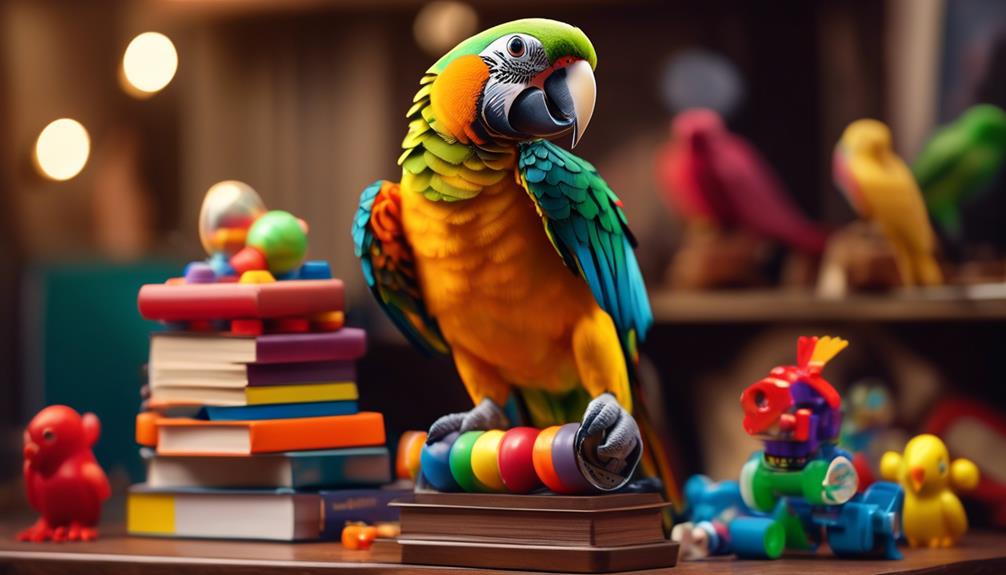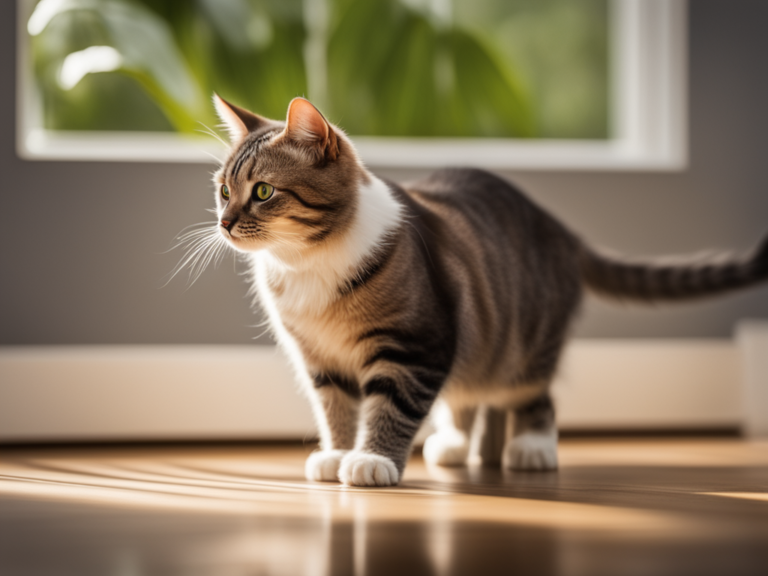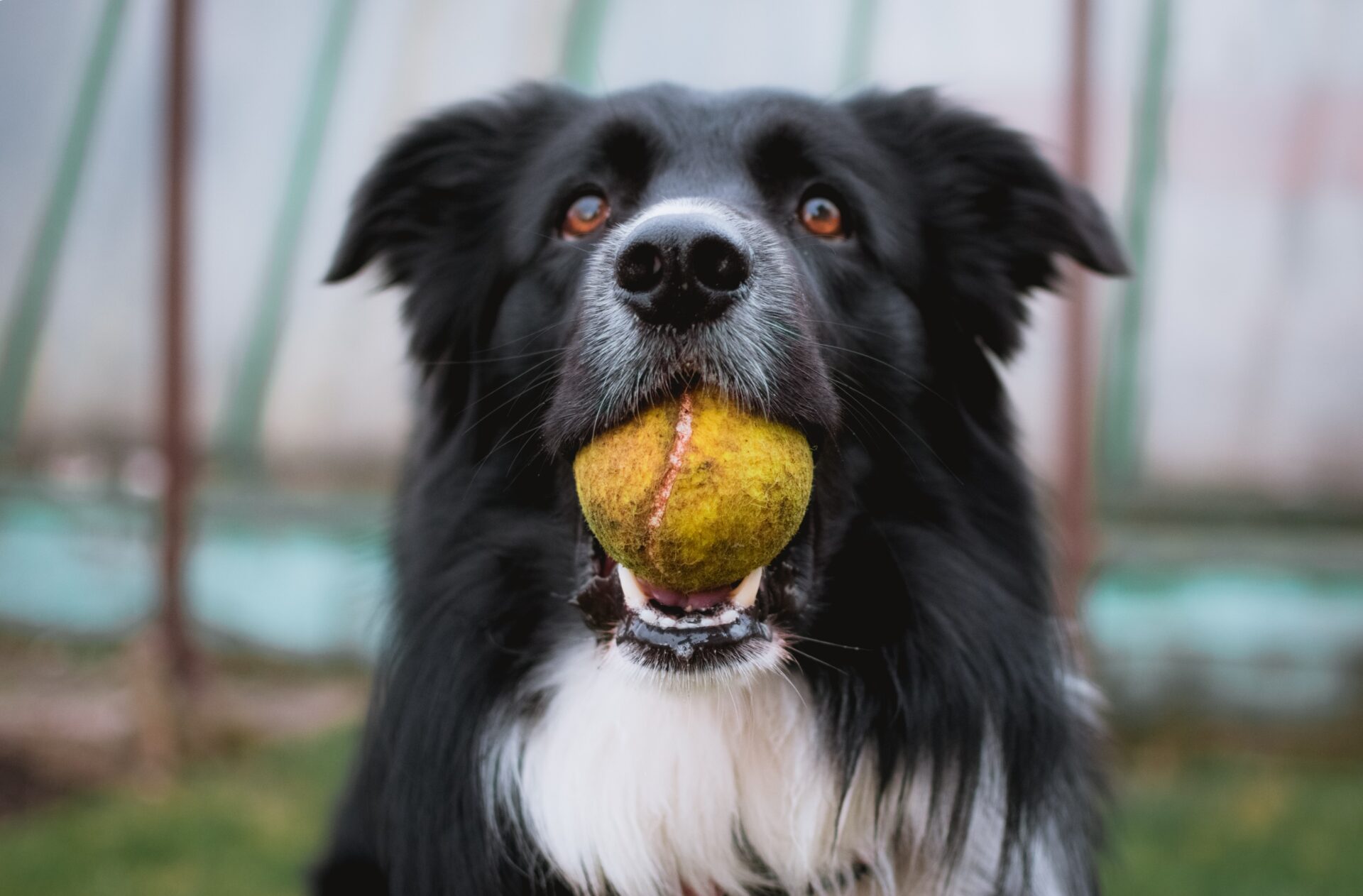Teach Your Parrot To Speak: A Simple Guide

Teach Your Parrot To Speak: Step into the world of avian communication and unlock the secret to teaching your parrot to speak with confidence and clarity. Like a whisper in the wind, the power of words can transform your feathered companion into a vocal virtuoso. But where do you begin? How do you navigate the vast landscape of parrot training? In this simple guide, you will uncover the key to unlocking your parrot’s linguistic potential, unravel the mysteries of effective communication, and embark on a journey that will forever change the dynamics between you and your feathered friend. Get ready to spread your wings and embark on a remarkable adventure that will leave you spellbound.
Getting to Know Your Parrot
To develop a strong bond with your parrot and gain a deep understanding of its species’ talking capabilities, it is crucial to invest time and effort into getting to know your feathered companion. This is the first step in teaching your parrot to speak. Getting to know your parrot involves creating an environment that is conducive to learning and building trust. Start by choosing simple starter words like “hello,” “bye-bye,” and your parrot’s name. Use a happy and positive tone when speaking to your parrot, as this will encourage them to engage and mimic your speech.
Repetition is key when teaching your parrot to speak. Repeat the chosen words frequently, ensuring that your parrot hears them consistently. Consider using training aids, such as recorded speech or videos, to reinforce the words you want your parrot to learn. It is important to be patient with your parrot’s progress as they may take some time to grasp the concept and begin vocalizing the words.
Establishing a training routine is essential. Set aside dedicated time each day to work on teaching your parrot to speak. Pay close attention to your parrot’s vocalizations and environmental sounds, as these can provide valuable insights into their learning process. By observing their responses and reactions, you can tailor your training approach to suit their individual needs.
Creating a social environment is also crucial in teaching your parrot to speak. Engage in regular conversations with your parrot, using positive reinforcement to encourage them to participate. By familiarizing your parrot with your voice and making them feel included in social interactions, you will enhance their motivation to communicate through speech.
Choosing the Right Words
To effectively choose the right words to teach your parrot to speak, it is important to observe its responses and select the ones that capture its interest and elicit the most positive reactions. Start with a few short, simple words such as ‘hello,’ ‘bye-bye,’ and your bird’s name to begin speech training. Pay attention to your parrot’s behavior when you say these words and note any signs of engagement or excitement. Use a happy and positive tone, as parrots tend to respond better to enthusiastic, high-pitched words.
It’s crucial to repeat the chosen word as frequently as possible. Parrots learn through repetition, so saying the word consistently will help them remember and understand its meaning. Simple words said with enthusiasm will keep them engaged and motivated to learn. Take note of the words that elicit the most positive responses from your parrot and focus on those. Each parrot is unique, so the words that capture their interest may vary.
However, it’s important to manage your expectations. Not all birds can talk, and some species are better talkers than others. Some parrots may not have the ability or the inclination to mimic human speech. It’s essential to recognize and respect your parrot’s individual capabilities. Remember that teaching your parrot to speak is a gradual process, requiring patience and consistency.
Consistent Repetition for Success
Consistent repetition is a fundamental aspect of teaching a parrot to speak effectively. It is through repeated exposure to specific words or phrases that a bird can learn to mimic and eventually produce those sounds. When you teach your parrot to speak, consistent repetition is the key to success.
Repeating a chosen word frequently to your parrot is crucial for successful speech training. By consistently exposing your parrot to the same word or phrase, you are helping it develop the necessary neural pathways for speech production. The more often the word is repeated, the more likely your parrot is to remember and imitate it.
Parrots learn to mimic through consistent repetition, making it a key factor for success. These intelligent birds can imitate human speech, but it requires regular and repetitive training. By consistently exposing your parrot to the same sounds, you are encouraging it to mimic and eventually produce those sounds on its own.
To enhance the learning process, you can use consistent repetition and training aids like tape recorders or CDs. These tools can help reinforce the chosen words or phrases by providing additional auditory stimulation. By playing recordings of the desired sounds, you are giving your parrot more opportunities to hear and imitate them.
Establishing a training routine and consistently working with your bird every day are crucial for success in teaching your parrot to talk. Consistency is key when it comes to teaching any new skill, and speech training is no exception. By dedicating regular time and effort to the training process, you are setting your parrot up for success and increasing the likelihood of it developing speech abilities.
Patience and Persistence Pays Off
To successfully teach your parrot to speak, it is crucial to understand the importance of patience and persistence. Training techniques, such as consistent practice and positive reinforcement, are key factors in achieving success. By establishing a routine and working with your parrot every day, you can reinforce learning and encourage progress.
Training Techniques
Establishing a consistent and regular training routine is crucial for teaching your parrot to speak and requires patience and persistence. Consistency is key in the learning process, as repetition of the chosen word helps your bird grasp the concept. Make sure to repeat the word frequently and consistently to aid in their learning. It is also important to establish a daily training routine and work with your birds regularly to foster their progress. Understand that success in speech training may take time, so be patient and persistent in your efforts.
If teaching words is taking longer than expected, consider starting with simpler tasks like whistling to keep the learning process engaging. Pay attention to your bird’s vocalizations and recognize environmental sounds to understand their communication patterns. With these training techniques, you can help your parrot species learn to talk and become a talking bird.
Consistent Practice
Developing a consistent and persistent practice routine is crucial for successfully teaching your parrot to speak. Patience and persistence will pay off in the long run. To start, choose a few words or phrases that you want your parrot to learn. Repeat these chosen words consistently, using a clear and distinct voice. The more you repeat, the more your parrot will learn and mimic over time.
Establish a training routine and work with your bird every day. Consistency is key. Keep in mind that success is not guaranteed, and each bird learns at their own pace. Some parrots may take months or even years to say their first word. Pay attention to your bird’s vocalizations and adapt the training if necessary. Remember, consistent practice is the key to teaching your parrot to speak.
Positive Reinforcement
Consistently reinforcing and rewarding your parrot’s attempts at speaking is crucial to positively encourage its progress. Positive reinforcement is an effective technique to teach your parrot to speak. During training sessions, when your pet parrot attempts to repeat the words, provide immediate praise and rewards such as treats or verbal affirmations. This positive feedback reinforces the desired behavior, making your parrot more likely to continue speaking.
Remember, each bird learns at its own pace, and some parrots may take months or even years to say their first word. Patience and persistence are key. Establish a training routine and work with your parrot every day, consistently reinforcing its attempts at speaking to foster progress. Celebrate even the smallest achievements and continue the training with patience and consistency to reinforce positive behavior.
Tips for Teaching Simple Words
To teach your parrot simple words, you can utilize the word repetition technique and positive reinforcement method. By repeating the chosen word frequently and using a happy and positive tone, you can encourage your bird to learn and mimic the word. Additionally, incorporating training aids like tape recorders or CDs can enhance the learning process.
Word Repetition Technique
Use frequent repetition of the chosen word to reinforce the association in your parrot’s learning process. Parrots learn to mimic through repetition, so it is crucial to repeat the word as frequently as you can. This technique helps your parrot understand the word and eventually learn to speak it. When speaking to your parrot, use a happy and positive tone, as simple words said with enthusiasm are more interesting to most parrots.
Additionally, you can consider using tape recorders or CDs as supplemental training aids, but remember that they are not a substitute for one-on-one interaction. To reinforce the word repetition technique, use extra learning tools in addition to direct teaching. By following these methods, you can effectively teach your parrot to speak.
Positive Reinforcement Method
To further enhance your parrot’s learning process, the positive reinforcement method can be incredibly effective in teaching simple words. During training sessions, keep them short and focused to maintain your parrot’s attention. Start by selecting a specific word you want to teach and repeat it consistently during the session. When your parrot attempts to mimic the word, provide immediate positive reinforcement.
Use phrases like “Good job!” or “Good bird!” in a happy and encouraging tone to praise your parrot’s efforts. It’s important to reinforce its learning by providing treats or affection when your parrot successfully mimics the word. Celebrate each milestone and continue the training with patience and consistency to encourage further learning. Remember to always maintain a positive and happy tone when speaking to your parrot to create a positive learning environment.
Using Treats as a Motivator
Treats can be a valuable tool in motivating your parrot to speak by providing positive reinforcement for their verbal attempts. When your parrot attempts to speak a word that you have been repeating, it is important to reward them with treats or affection to encourage the behavior. This helps your parrot associate speaking with receiving a reward, reinforcing the connection and increasing their desire to continue speaking.
Using treats as a motivator can be an effective way to train your parrot to speak, as it taps into their natural desire for food and rewards. By offering treats when your parrot successfully mimics a word, you are reinforcing the behavior and encouraging them to continue speaking. This positive reinforcement method helps your parrot understand that speaking is desirable and leads to a pleasurable outcome.
However, it is important to avoid giving treats when your parrot is not talking. This is crucial to maintain the association between speaking and receiving a reward. If treats are given randomly or without any connection to their verbal attempts, it can confuse your parrot and make the training process less effective.
While treats can be a powerful motivator, it is essential to use them in moderation and as a supplement to other forms of positive reinforcement. This ensures that your parrot does not become solely dependent on treats for motivation. Affection, praise, and playtime should also be incorporated into the training process to create a well-rounded approach.
Encouraging Longer Phrases and Songs
Encouraging your parrot to vocalize longer phrases and songs can be achieved through the use of positive reinforcement and a patient, repetitive teaching approach. To teach your parrot longer phrases, start by rewarding it whenever it attempts to say longer words or phrases. By using positive reinforcement, such as treats and praise, you can motivate your parrot to continue trying to vocalize longer phrases.
In addition to positive reinforcement, it is important to provide clear and enthusiastic examples for your parrot to imitate. Sing or repeat longer phrases and songs in a melodious and distinct manner, making sure to enunciate each word clearly. This will help your parrot understand the sounds and pronunciation of longer phrases, making it easier for them to imitate.
Repetition and patience are key when teaching your parrot longer phrases and songs. Break down longer phrases into smaller parts and practice them regularly with your parrot. Gradually increase the complexity of the phrases as your parrot becomes more comfortable and proficient. Remember to be patient and understanding, as each parrot learns at its own pace.
To create a fun and engaging learning environment, introduce music and sing along with your parrot. This will encourage your parrot to vocalize and imitate longer phrases and songs. Singing together can also strengthen the bond between you and your parrot, making the learning process more enjoyable for both of you.
Expert Q&A: Common Questions Answered
In the realm of teaching parrots to speak, experts often encounter common questions from bird owners seeking guidance and advice. Here are some of the most frequently asked questions and their answers:
- Can all birds be taught to speak?
Not all birds have the ability to mimic human speech. While parrots are known for their talking abilities, other bird species may not possess this skill. It’s important to recognize that each bird is unique, and managing your expectations is crucial. Some birds may never learn to speak, while others may surprise you with their vocabulary. - How do I start teaching my bird to speak?
To begin teaching your parrot to speak, choose a few short, simple words such as “hello,” “bye-bye,” or your bird’s name. Repeat these words to your bird frequently, as parrots learn through repetition. Be patient and consistent in your training efforts. - Is there a specific training routine I should follow?
Establishing a training routine is essential when teaching your parrot to speak. Work with your bird every day, dedicating a specific time for training sessions. Consistency is key, but it’s important to understand that success is not guaranteed. Some birds may pick up words quickly, while others may take longer to learn. - Where should I place my parrot’s cage for optimal learning?
To encourage interaction and learning, place your parrot’s cage in a central room with a lot of human traffic. This will expose your bird to different sounds and conversations, stimulating their desire to mimic speech. Avoid placing the cage in the kitchen or bathroom due to temperature variations and potential exposure to toxins.
Best Practices for Training Sessions
To ensure effective training sessions, it is important to consider two key points: session duration and positive reinforcement. Keep your training sessions short and frequent, as this will maintain your parrot’s attention and prevent fatigue. Additionally, make use of positive reinforcement, such as treats or praise, to encourage your parrot when it attempts to mimic words or phrases. Following these best practices will help create a structured and rewarding training environment for your parrot.
Session Duration
The ideal duration for training sessions when teaching your parrot to speak is to keep them short, around 5-10 minutes, to maintain the bird’s attention and focus. This is important because parrots have a limited attention span and can easily become bored or distracted. By keeping the sessions brief, you can ensure that your parrot stays engaged and motivated to learn.
Consistency is also key, so it is better to have multiple short sessions throughout the day rather than one long session. Pay attention to your parrot’s body language and energy levels to gauge the ideal duration for training sessions. As your parrot becomes more accustomed to learning and speaking, you can gradually increase the duration of the sessions. Remember to end each training session on a positive note to keep your parrot eager and willing to participate in future sessions.
Positive Reinforcement
Use positive reinforcement techniques, such as praise and treats, to reinforce desired behaviors during your parrot’s training sessions. Consistently reward your parrot with treats or affection when it successfully mimics a word, using positive reinforcement. This method encourages your bird to associate speaking with positive experiences, motivating them to continue learning new words and phrases. Celebrate your parrot’s progress and continue the training with patience and consistency.
Remember to avoid punishment or negative reinforcement, as this can confuse and distress your parrot, hindering the learning process. By creating a positive and encouraging environment during training sessions, you can effectively teach your parrot to speak. Positive reinforcement is a key component in helping your bird learn and develop their language skills.
Importance of Bonding With Your Parrot
Bonding with your parrot is crucial for fostering a strong and lasting relationship, as well as promoting their overall well-being and behavioral development. When you take the time to bond with your parrot, you are creating a foundation of trust and understanding that will make the process of teaching them to speak much easier.
Parrots are highly social creatures and thrive on companionship. By bonding with your parrot, you are fulfilling their need for social interaction and reducing feelings of loneliness or boredom. This is particularly important for parrots that are kept as pets, as they rely on human companionship for their emotional well-being.
A strong bond with your parrot also plays a significant role in their behavioral development. When they feel secure and connected to you, they are more likely to exhibit positive behaviors and be receptive to training. On the other hand, a lack of bonding can lead to behavioral issues such as aggression, excessive vocalization, or self-destructive behavior.
To bond with your parrot, spend quality time with them daily. This can include activities such as talking to them, playing games, offering treats, or simply sitting near their cage. Be patient, consistent, and gentle in your interactions, and avoid any actions that may cause fear or stress.
Teach Your Parrot To Speak Frequently Asked Questions
How Do You Teach a Parrot to Talk for Beginners?
To teach your parrot to talk, repetition is key. Create a positive learning environment by using positive reinforcement techniques and incorporating mimicry and imitation. Overcome challenges by being patient and adapting to your bird’s individual pace.
What Are the Easiest Words to Teach a Parrot?
The easiest words to teach a parrot are simple and short ones like ‘hello’ and ‘bye-bye’. Use a happy and positive tone, repeat the words frequently, and observe your parrot’s response.
How Do You Teach a Parrot to Say?
To teach your parrot to speak, use effective techniques like repetition and positive reinforcement. Choose simple words that are easy for your parrot to learn. Overcome common challenges by bonding with your bird and understanding its speech patterns.
What Is the Easiest Parrot to Teach to Talk?
The African Grey is the easiest parrot to teach to talk. Follow these tips to teach your parrot to talk from scratch. Common phrases parrots love to mimic and learn the art of training parrots to speak on command. Unlock your parrot’s potential with advanced talking techniques.
Teach Your Parrot To Speak Conclusion
In conclusion, ‘Teach Your Parrot To Speak: A Simple Guide’ offers valuable insights and expert advice on training your parrot to talk. With step-by-step instructions and a comprehensive approach, this guide emphasizes the importance of understanding your bird, choosing the right words, consistent repetition, patience, and bonding. By following the techniques and tips provided in this book, parrot owners can successfully teach their birds to speak and strengthen their bond with their feathered companions. This guide is a must-have resource for any parrot owner seeking to unlock their bird’s speaking abilities.








